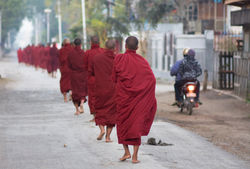
Bagan is a beautiful ancient city located on the Eastern bank of the Ayeyarwaddy River, and Myanmar’s most popular tourist destination. Its rich history as the capital of the first Myanmar Empire means that the city is filled with ancient temples, buildings and artifacts whose origins date back as far as 1,500 years ago. Culture and history buffs will be delighted in the numerous temples, pagodas, monuments, stone scripts, votive tablets, wall paintings, mural paintings and stuccos carvings easily found throughout the city.
Key places of interest include the Shwezigon, Ananda, Dhammayangyi and Thabbyinnyu Pagodas. Take a ride on a hot air balloon for an aerial view of the city. Flights typically take place at sunset or sunrise, giving visitors the best view of Bagan’s famously beautiful golden sunsets. A quick and easy way to see Bagan is by hiring a horse cart. These are run by the locals, so you’ll often get your very own tour guide as well. However, those who are up for an adventure can rent a bicycle and venture the pagoda-studded plain themself.
BAGAN
WHAT TO DO AND SEE
 Balloons over BaganFor the best view of pagoda-studded plain of Bagan, get on one of these balloons during sunrise or sunset. |  Mount PopaMount Popa is an extinct volcano that is estimated to have erupted for the final time, over 320,000 years ago. The violence of Mount Popa’s active explosions can still be seen in the abundant petrified trees and huge boulders found around the Bagan area. Today, Mount Popa is a popular pilgrimage site for locals who believe that many spirits of ancient ancestors, or ‘Nats’, dwell in the mountain. |  Bagan Archeological MuseumThe museum run by the Archeological Department is situated near the Gawdawpalin Temple. It has a collection of more than 2,000 items including Buddha statues, fragments of architecture, stone inscriptions, terracotta cups and pots, etc. |
|---|---|---|
 Ananda TempleCompleted in AD 1091 by King Kyanzittha, the name of this most majestic of temples means endless wisdom and symbolizes the wisdom the Buddha. This Temple is the "mother of all temples" in Bagan, containing representative works of all the arts, architecture, glazed plaques, woodcarvings, stucco, terra cotta and stone sculptures found in all Myanmar temples. |  Daily Alms Giving |  Gawdawpalin TempleThis temple was built by King Narapatisithu during the 12th century. It is about 60 meters high with a fine view over the ruins of the Bagan plains and the mighty Ayeyarwaddy River. |
 Dhammayangyi TempleOne of the messive temple of Bagan. Built in 1163 by king Narathu, Dhammanyangyi temple is noted for its fine brickwork, the bricks fitting so close togther that there is hardly any space between ingalazedi. |  Thatbyinnyu TempleOver 66 meters high, and built by King Alaungsithu in the middle of the 12th century, this white stucco building overtops all other monuments as the highest pagoda on the Bagan plain. |  Sulamani TempleSulamani (occasionally Sulamuni) Guphaya, or Pahto, is one of Bagan's premier temple attractions. The name itself means Crowning Jewel or Small Ruby. It was the first and most important temple of the late period (1170-1300) of Bagan monument building. It was one of many temples and stupas built by Narapatisithu. This temple is similar to Htilominlo and Gawdawpalin in architecture but with better interior lighting. |
 Shwezigon PagodaCommenced by Anawrahta but completed by his son, King Kyansittha, it is a prototype for later Myanmar pagodas. It is Bagan's biggest and one of the most important pagoda. It also is one of the most venerated pagodas in Myanmar as it is believed to enshrine Buddha's tooth and bone. |





